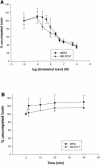Introduction of Culex toxicity into Bacillus thuringiensis Cry4Ba by protein engineering
- PMID: 12957922
- PMCID: PMC194974
- DOI: 10.1128/AEM.69.9.5343-5353.2003
Introduction of Culex toxicity into Bacillus thuringiensis Cry4Ba by protein engineering
Abstract
Bacillus thuringiensis mosquitocidal toxin Cry4Ba has no significant natural activity against Culex quinquefasciatus or Culex pipiens (50% lethal concentrations [LC(50)], >80,000 and >20,000 ng/ml, respectively). We introduced amino acid substitutions in three putative loops of domain II of Cry4Ba. The mutant proteins were tested on four different species of mosquitoes, Aedes aegypti, Anopheles quadrimaculatus, C. quinquefasciatus, and C. pipiens. Putative loop 1 and 2 exchanges eliminated activity towards A. aegypti and A. quadrimaculatus. Mutations in a putative loop 3 resulted in a final increase in toxicity of >700-fold and >285-fold against C. quinquefasciatus (LC(50) congruent with 114 ng/ml) and C. pipiens (LC(50) 37 ng/ml), respectively. The enhanced protein (mutein) has very little negative effect on the activity against Anopheles or AEDES: These results suggest that the introduction of short variable sequences of the loop regions from one toxin into another might provide a general rational design approach to enhancing B. thuringiensis Cry toxins.
Figures








References
-
- Angsuthanasombat, C., N. Crickmore, and D. J. Ellar. 1992. Comparison of Bacillus thuringiensis subsp. israelensis CryIVA and CryIVB cloned toxins reveals synergism in vivo. FEMS Microbiol. Lett. 94:63-68. - PubMed
-
- Angsuthanasombat, C., N. Crickmore, and D. J. Ellar. 1993. Effects on toxicity of eliminating a cleavage site in a predicted interhelical loop in Bacillus thuringiensis CryIVB delta endotoxin. FEMS Microbiol. Lett. 111:255-261. - PubMed
-
- Bar, E., J. Lieman-Hurwitz, E. Rahamim, A. Keynan, and N. Sandler. 1991. Cloning and expression of Bacillus thuringiensis israelensis δ-endotoxin in B. sphaericus. J. Invertebr. Pathol. 57:149-158. - PubMed
-
- Becker, N., and J. Margalit. 1993. Use of Bacillus thuringiensis israelensis against mosquitoes and blackflies, p. 145-170. In P. F. Entwistle, P. F. Cory, M. J. Bailey, and S. Higgs (ed.), Bacillus thuringiensis, an environmental biopesticide: theory and practice. John Wiley & Sons, Inc., New York, N.Y.
Publication types
MeSH terms
Substances
Grants and funding
LinkOut - more resources
Full Text Sources
Other Literature Sources

